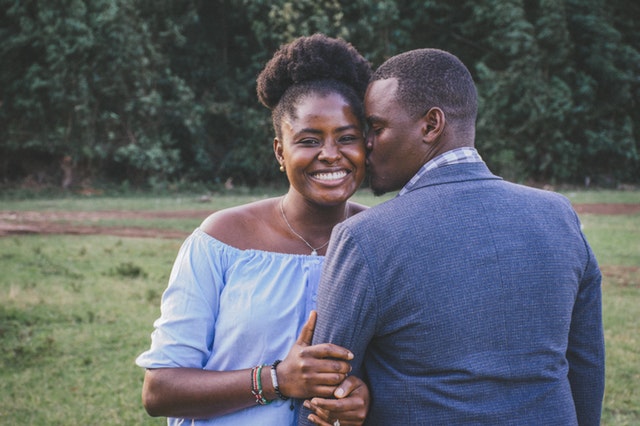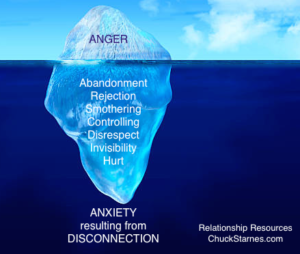Debbie said she had only one problem in her marriage! It was her husband, Will!
‘Our counselor told us Will has to work on himself before we can ever have a healthy relationship!’
Debbie and Will were in a storm of conflict and she was blaming it all on him.
Will had ‘anger issues‘ so in Debbie’s eyes he was 100% to blame for their problems. He got labeled by their prior counselor as the ‘bad spouse’ and she was the ‘good spouse’.
But we soon discovered that Debbie’s fear of intimacy was preventing her from connecting with Will. And her withdrawal from him during times of conflict was activating Will’s childhood feelings of rejection. That’s when he would react with outbursts of anger.
His anger, in turn, made her feel smothered until she would then blow up. And the raging storm of conflict continued!
In a storm of conflict like this, the problem is not you or your partner, it’s the ‘space-between’.
What?!
Their problem wasn’t Will. And it wasn’t Debbie.
It was ‘the space between’!
The ‘space between’ them was filled with negativity, making the relationship unsafe. Both were adding to that negativity in their own way. Will by his uncontrolled anger. Debbie by her fear of intimacy, retreating, and then blowing up.
An intimate partnership is not just two individuals interacting. It’s two people plus the ‘space between’ them.
A marriage relationship is like the physical universe in two ways: (1) everything is connected, and (2) the space between planets is not just empty space. There are massive energy fields at work to hold everything together.
In the same way, you and your partner are connected, and the space between you is not just empty space.
The space between you is filled with either positive or negative energy. And that’s what determines the quality of your relationship and your life. Whatever you put into that space has the power to shape and change your lives more than any other force.
So, to fix your relationship, you can’t just fix your partner or fix yourself. You have to fix the ‘space between’.
Filling the space between with positive energy makes it safe to reconnect. And when you reconnect all the problems you want to solve actually dissolve.
That’s when the storm of conflict can be transformed into a refuge of healing.
Here are three powerful steps Will took to turn their marriage from a storm of conflict into a refuge of healing.
1. Commit to Zero Negativity
If there is ANY negativity in the space between you in the form of criticism, judgement, an eye roll, or even going silent when your partner is overreacting, the relationship will not feel safe to either of you. And negativity will always keep you from connecting with each other.
So make a commitment to eliminate ALL negativity in the space between. Then, when you slip up, repair it immediately so you don’t fall back into the same old pattern of allowing negativity into the space between.
Debbie could NOT stop her negative reactions, but Will tried hard to stick to it even when things turned ugly.
As Will continued to refrain from any put downs, the space between began to slowly change.
Will was demonstrating how one partner can change the dynamics of the relationship with a zero negativity commitment. Click on the link to download the tool.
2. Share 3 ‘Appreciations’ with your partner every day.
The way to get beyond the one negative thing you’re stuck on about your partner is to point out the myriad of things that are positive.
What you focus on is what you will get.
If you focus on what your partner does wrong all the neural pathways of anger and fear will continue to get reinforced. Then the accompanying neurochemicals of cortisol and adrenaline – the neurochemicals of fear and anxiety flood your system giving fuel to the storm of conflict.
But if you focus on your partner’s positive qualities your brain releases the pleasure neurochemicals of dopamine, endorphins, and oxytocin – neurochemicals of pleasure that make you feel safe, wonderful, and alive.
Recent discoveries about the brain have given us new hope that we can change our way of relating and turn that storm of conflict into a refuge of healing.
Turns out our brains are’ plastic’. This means that we can reshape our neural pathways. By choosing what you think about, you have the power to change your own brain and your feelings as well.
The more we bring these appreciations into the ‘space between’, the more neurochemicals of well-being, wonder, and full-aliveness are released. And the more the space between is filled with positive energy and safety. Click here to download the Appreciation Tool.
3. Use Safe Conversation skills
Eliminating negativity doesn’t mean you don’t deal with negative issues.
You have to talk about negative things, but you can do it in a positive way, keeping the space between you a negativity-free zone.
Safe Conversations skills (aka The Couple’s Dialogue) can help you talk without put downs.
It’s not what you say, it’s how you say it that makes it positive or negative.
The Couple’s Dialogue will help you slow down and mirror (listening to 100% of what your partner is saying), validate (letting your partner know she or he makes sense), and empathize (feeling what your partner feels). Click here to download this tool.
Will used these skills trying make it safe for Debbie, but it seemed to only escalate her anger.
Debbie began accusing Will of things that simply ‘were not true’.
It seemed like they would never catch a break from this storm of conflict.
But a miracle happened as Will continued to regulate his own reactions by mirroring Debbie as she shared her feelings.
Even though her accusations were unfair, and her feelings seemed unwarranted, Will continued to mirror, validate, and empathize with her until he literally dissolved all her criticism and negativity!
That was a breakthrough! Why?
Criticisms are simply a wish in disguise.
Behind all Debbie’s hateful words and wrongful accusations was a hidden desire to be connected with Will.
When it became safe for her to reconnect with him, all those criticisms melted away.
When you make it safe for your partner to share ANYTHING, you can dissolve all their criticism, and melt all their accusations.
Isn’t that better than defending yourself and trying to prove your partner wrong?
What about you and your partner? Are you in a storm of conflict?
- Get rid of ALL negativity.
- Share 3 appreciations with your partner each day.
- Use Safe Conversation skills to share your frustrations.
And you can quell that storm of conflict and transform your marriage into a refuge of healing!



